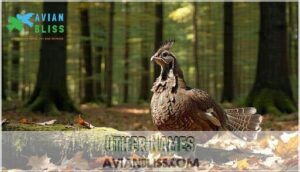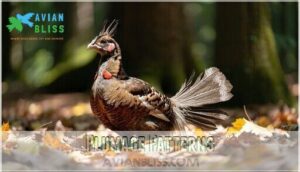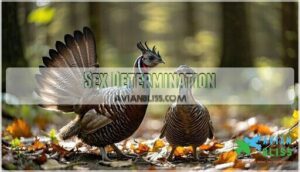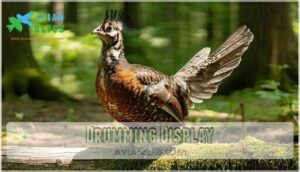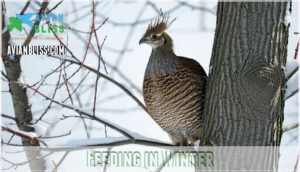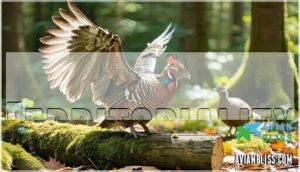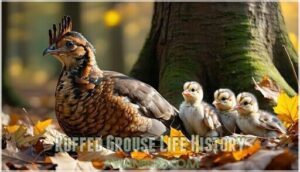This site is supported by our readers. We may earn a commission, at no cost to you, if you purchase through links.

These chicken-sized forest birds are famous for their explosive takeoffs when startled and the male’s thunderous wing-drumming display during mating season.
They’re masters of camouflage, blending perfectly into deciduous and mixed forests across northern and eastern North America.
In winter, they grow feathered "snowshoes" on their feet and plunge into snow banks for warmth, and their diet shifts seasonally from ground insects and berries to tree buds when snow covers the forest floor, making them remarkably adaptable survivors.
Table Of Contents
- Key Takeaways
- Ruffed Grouse Identification
- Ruffed Grouse Behavior
- Ruffed Grouse Habitat
- Ruffed Grouse Life History
- Ruffed Grouse Distribution
- Frequently Asked Questions (FAQs)
- What states are ruffed grouse in?
- Are ruffed grouse good to eat?
- Do ruffed grouse make noise?
- Will a grouse chase you?
- What is unique about a ruffed grouse?
- Are grouse good to eat?
- Can ruffed grouse fly?
- What is the mating ritual of ruffed grouse?
- How do ruffed grouse adapt to climate change?
- What are the main predators of ruffed grouse?
- Conclusion
Key Takeaways
- You’ll identify ruffed grouse by their mottled brown plumage, fan-shaped tail with dark bands, and explosive takeoff when startled – they’re perfectly camouflaged for forest life.
- You’ll hear males drumming from up to a quarter-mile away as they beat their wings on logs to attract mates and defend territory during breeding season.
- You’ll find these adaptable birds switching from ground insects and berries in summer to tree buds and twigs in winter, even growing feathered "snowshoes" for snow survival.
- You’ll encounter them in young forests with dense undergrowth across 38 states, from Alaska to northern Georgia, where they thrive in mixed deciduous and coniferous woodlands.
Ruffed Grouse Identification
You’ll recognize a Ruffed Grouse by its medium size (16-19 inches), brown to gray-brown plumage with intricate barring, and distinctive fan-shaped tail with dark bands near the tip.
Look for that distinctive fan-shaped tail with dark bands—it’s your best field mark for identifying these forest birds.
The bird’s most notable feature is the black neck ruff that males display during courtship, along with a small pointed crest and well-camouflaged chickenlike appearance.
Physical Characteristics
Ruffed grouse display remarkable plumage coloration that helps with bird identification in the field.
You’ll notice these medium-sized birds show two distinct color morphs – grayish-brown or reddish-brown phases.
Their intricate feather patterns create excellent camouflage against forest floors.
Key physical features include:
- Size Variation: 16-19 inches long, weighing 17-25 ounces
- Tail Morphology: Fan-shaped with distinctive dark bands near the tip
- Ruff Size: Black neck feathers form prominent ruffs during displays
- Beak Shape: Short, curved, and sturdy for varied feeding
- Crest: Small pointed feathers create a subtle head crest
The tail shape serves as your best identification marker – it’s squared and relatively long compared to other forest birds.
Similar Species
Several grouse species can confuse birders, but key features help you tell them apart.
Spruce Grouse lacks the ruffed grouse’s distinctive tail band and prefers dense conifers.
Dusky Grouse appears larger with less barring, favoring mountain forests.
Sharp-tailed Grouse sports a pointed tail and white spots, choosing grasslands over woods.
Ptarmigan changes color seasonally, unlike the consistent patterns you’ll see year-round, which is a distinctive feature.
Other Names
You’ll encounter this North American bird species under various local nicknames and regional variations across its range.
Common names include "partridge" in New England, "pat" among hunters, and "drummer" referencing their distinctive wing-beating display.
The scientific name Bonasa umbellus reflects their ruffled neck feathers.
Historical names like "wood grouse" describe their forest habitat, while some mistakenly call them "pheasants.
Plumage Patterns
You’ll find ruffed grouse display remarkable camouflage evolution through their intricate plumage patterns.
These birds show two distinct color morphs – grayish and reddish-brown phases that help them blend into different forest environments.
Regional variations exist across their range, with tail color varying by location, and their feather development creates complex barring and streaking that provides perfect woodland camouflage throughout the molting process.
These patterns are key to overall bird identification and aid in overall understanding of the species, showcasing their unique plumage patterns.
Sex Determination
Determining sex in ruffed grouse requires keen observation since males and females share similar plumage.
Males typically weigh more and display longer tail feathers with distinctive dark bands near the tips. The ruff size also differs between sexes during courtship displays.
- Tail Shape: Males have broader, more rounded tails while females show narrower, squared-off tail tips
- Rump Feathers: Look for subtle pattern differences in the lower back feathering between males and females
- Weight Differences: Males average 1-2 ounces heavier than females, though this requires handling the bird
- Plumage Bands: About 77% of males display prominent dark bands near their tail ends, a key identification feature
Ruffed Grouse Behavior
You’ll witness some of nature’s most fascinating behaviors when observing Ruffed Grouse throughout the year.
These forest birds display remarkable adaptations from their explosive flush flights to the male’s thunderous drumming displays that can be heard a quarter-mile away.
Drumming Display
You’ll hear a ruffed grouse’s drumming sound long before spotting the bird.
Males create this percussive display by rapidly beating their wings while standing on logs, stumps, or rocks. The drumming starts slowly and accelerates into a thunderous roll that echoes through the forest.
| Drumming Aspect | Details | Purpose |
|---|---|---|
| Season | Peak activity in spring, occurs year-round | Courtship displays and territorial defense |
| Locations | Fallen logs, boulders, stumps in clearings | Strategic positioning for sound projection |
| Competition | Males drum to warn rivals, attract females | Establishes dominance without physical contact |
This territorial defense mechanism carries up to a quarter-mile, making it one of nature’s most effective long-distance communication systems.
Foraging Habits
You’ll spot ruffed grouse scratching through leaf litter and underbrush, searching for their diverse grouse diet.
They frequent foraging locations near small trees and dense cover, occasionally venturing onto roads for essential grit consumption.
Their diet adaptations include switching from insects and seeds to woody materials as seasons change, and they adapt their seasonal diet from spring buds and berries to winter browse.
Feeding in Winter
Winter transforms the ruffed grouse’s world into a survival challenge.
Their winter diet shifts dramatically—over 95% becomes buds, twigs, and catkins from trees like aspen, birch, willow, and hazel.
You’ll spot them perching in bare treetops, avoiding ground foraging in deep snow.
They burrow into powdery snow for overnight roosting, conserving precious energy during harsh months when food scarcity tests their limits.
Supplemental winter feeding products can also support grouse during these lean times.
Displaying Males
Male Ruffed Grouse frequently put on spectacular spring displays to attract mates and defend their territory.
During peak breeding season, these feathered performers transform into drumming machines, creating thunderous beats that echo through the forest like nature’s own percussion section.
- Drumming Mechanics: Males beat their wings rapidly while standing on logs, creating air compression that produces the signature thumping sound
- Display Frequency: Peak drumming occurs during spring mating season, though males may drum year-round for territory defense
- Territory Defense: The drumming sound travels up to a quarter-mile, warning rival males to stay away from claimed areas
- Mate Attraction: Females locate potential partners by following the distinctive drumroll-like advertising calls through the woods
Territoriality
Ruffed grouse males fiercely defend their territory through drumming displays and aggressive posturing.
Each male controls roughly 10 acres, sharing space with one or two females.
When rival males intrude, territory defense intensifies with louder drumming and direct confrontation.
This territorial behavior guarantees access to prime nesting sites and food resources.
Males patrol boundaries regularly, using drumming as both warning and advertisement to maintain their domain throughout breeding season.
Securing these resources is a key part of territoriality benefits, which highlights the importance of territorial behavior and access to food resources.
Ruffed Grouse Habitat
You’ll find ruffed grouse in young forests with thick undergrowth, especially where logging or natural disturbances have created dense cover.
These birds prefer mixed deciduous and coniferous woodlands with scattered clearings, from the Appalachians all the way to Alaska.
Forest Types
Where do these woodland birds call home? Ruffed grouse thrive in deciduous forests, mixed woodlands, and coniferous habitats across North America.
They show strong deciduous preference, especially for aspen and birch stands. Forest succession creates ideal conditions when logging or fires produce dense understory growth.
Regional variations exist, with northern populations favoring mixed forests while southern birds prefer deciduous forests with scattered clearings and thick undergrowth.
Forested Roads
You’ll occasionally spot ruffed grouse along forested roads, where they venture out to pick up essential grit for digestion.
These roadside encounters create both opportunities and challenges for wildlife conservation efforts.
Key roadside concerns include:
- Vehicle Collisions – Grouse crossing roads face traffic dangers, especially during dawn and dusk foraging periods
- Habitat Fragmentation – Roads split continuous forest habitat into smaller, isolated patches that affect grouse populations
- Edge Effects – Road corridors alter nearby forest conditions, changing vegetation patterns and predator access to grouse habitat
Road management practices substantially impact ruffed grouse survival in forest habitat systems.
Effective strategies include sustainable road construction.
Bare Treetops in Winter
During winter’s harsh grip, you’ll spot ruffed grouse perched high in bare treetops, a behavior that seems counterintuitive but serves essential survival needs.
These exposed positions offer thermal cover from wind while providing access to winter diet staples like buds and catkins.
Snow roosting beneath trees becomes impossible when branches lack foliage, forcing grouse into open canopies.
This elevated positioning helps with predator avoidance during resource scarcity periods when ground-level food sources disappear under snow, providing access to winter diet staples.
Deciduous and Mixed Forests
You’ll find ruffed grouse thriving in deciduous forests and mixed forests where hardwoods blend with conifers.
These forest birds prefer areas with dense understory density that provides cover and food sources. Forest composition matters – aspen, birch, and oak create ideal conditions.
Edge effects between different forest types offer diverse feeding opportunities. While habitat fragmentation can threaten populations, well-connected woodlands support healthy grouse communities through seasonal changes, ensuring the well-connected woodlands are crucial for their survival.
Early Successional Stages
You’ll find ruffed grouse thrive in early succession stages where forest regeneration creates their ideal conditions.
Logging impacts and fire ecology naturally produce these young forest habitats with dense underbrush that grouse need. These disturbed areas offer abundant food sources and cover.
Wildlife benefits from habitat management that maintains these dynamic forest patches, supporting healthy ruffed grouse populations across their range.
Maintaining these habitats is key, as forest fragmentation reduces overall bird diversity to support healthy populations.
Ruffed Grouse Life History
Understanding the Ruffed Grouse’s life history reveals fascinating patterns of survival, reproduction, and seasonal adaptation that shape this remarkable bird’s existence.
From complex social behaviors to challenging mortality rates, these forest dwellers navigate a demanding cycle that determines their success across North America’s wooded landscapes, influenced by their ability to adapt to seasonal changes.
Social Behavior
Though solitary most of the year, ruffed grouse display fascinating social interactions during specific situations.
You’ll witness their most dramatic behaviors when they’re startled or threatened, showcasing remarkable survival strategies.
- Flushing Behavior: Explodes into flight with thunderous wingbeats when surprised, creating a startling distraction
- Predator Evasion: Females perform broken-wing displays to lead threats away from chicks
- Grit Gathering: Groups occasionally venture onto roadsides together, collecting essential digestive stones
Note: The above response has been revised to remove the unnecessary note at the end, as per the instructions to provide the reorganized text only, with no additional commentary, notes, or tags.
Feeding Habits
Ruffed grouse show remarkable dietary adaptations throughout the year, switching from ground foraging for insects and berries in summer to browsing buds and twigs in winter.
Their food preferences include aspen buds, which meet essential nutritional needs during harsh months.
These foraging strategies help them survive in dense underbrush where their bird diet varies seasonally, demonstrating impressive flexibility in seasonal foods selection.
Breeding and Nesting
Female grouse select their nest site carefully, choosing shallow depressions lined with leaves near tree bases or stumps.
The clutch size ranges from 8-14 eggs, with incubation lasting 23-24 days. During this incubation period, hens rarely leave their nests, maintaining constant warmth for proper chick development through dedicated parental care.
Some conservationists also use grouse nesting boxes to improve nesting success.
Key Breeding Facts:
- Nest Site Selection – Females choose ground locations with dense cover at tree or stump bases for protection
- Clutch Size Range – Hens lay 8-14 pinkish-buff eggs, sometimes spotted with dull brown markings
- Incubation Timeline – Eggs require 23-24 days of consistent warming before hatching occurs
- Nesting Season – Peak nesting activity happens from April through May across their range
- Chick Development – All eggs hatch synchronously, producing precocial chicks ready to leave immediately
Chick Mortality
After successful nesting, the harsh reality sets in.
Predation Impact devastates ruffed grouse broods, with up to 80% of chick deaths occurring within four weeks.
Hawks, owls, foxes, and raccoons pose constant threats, and Weather Effects compound mortality—rainy cold weather causes hypothermia in vulnerable grouse chicks.
Habitat Quality matters tremendously, as dense cover reduces predator detection, and Food Scarcity and Disease Prevalence add further stress.
Making survival a numbers game where accidents claim many, highlighting the challenges faced by these birds in their early stages of life.
Juvenile Dispersal
Young ruffed grouse don’t stick around home for long.
By late fall, these juveniles travel an average of 1-3 kilometers from their natal brood area to find their own territory.
This juvenile dispersal helps prevent inbreeding and reduces competition with family members.
The distance traveled depends on habitat quality and population density, with some birds moving much farther when suitable areas are scarce.
Ruffed Grouse Distribution
You’ll find Ruffed Grouse across a vast range spanning from Alaska to the Appalachian Mountains, making them one of North America’s most widespread forest birds.
Their populations thrive best in regions with consistent winter snow cover, where these hardy birds have adapted to survive harsh northern climates.
North America Range
You’ll find Ruffed Grouse across a vast North American range, spanning from Alaska’s wilderness to Georgia’s southern forests.
These adaptable North American Birds showcase remarkable Geographic Variation in Regional Abundance and Population Density throughout their territory.
Continental Distribution Highlights:
- Northern strongholds – Canada and Alaska support the highest Population Density
- Eastern extent – Range Maps show populations from Labrador to northern Alabama
- Western presence – Cascades and coastal ranges maintain stable numbers
Range Expansion has slowed recently due to Habitat Fragmentation at southern boundaries.
Isolated Populations
Beyond their main range, ruffed grouse populations exist in surprising pockets.
You’ll find them in South Dakota’s Black Hills and North Dakota’s Turtle Mountains, far from their typical habitat.
These isolated populations face unique challenges from habitat fragmentation, which limits genetic diversity and makes conservation efforts more complex.
Population fluctuations hit these small groups harder, making habitat restoration critical for their survival.
Snow Cover and Abundance
You’ll find ruffed grouse populations reach their peak numbers in regions with consistent snow cover lasting from late November through late March or early April.
This snow provides essential habitat insulation and affects winter survival rates substantially.
Snow depth plays a major role in ruffed grouse abundance:
- Deep snow creates protective roosts – birds burrow into powder for warmth during cold winters
- Regional variations show clear patterns – northern populations thrive where snow persists longest
- Climate effects influence population fluctuations – inconsistent weather disrupts traditional survival strategies
- Habitat insulation determines territory quality – areas with reliable snow cover support higher densities
Conservation Status
Across North America, ruffed grouse hold a conservation status of "Least Concern," yet Population Trends reveal troubling declines.
The species faces mounting pressure from Habitat Loss and changing Forest Management practices that reduce young forest habitat critical for survival.
| Conservation Metric | Current Status |
|---|---|
| IUCN Red List | Least Concern |
| Population Decline | 1-2% annually since 1960s |
| Habitat Reduction | 80% loss in some regions |
While Hunting Regulations help monitor populations, bird conservation efforts must address the underlying habitat crisis threatening this iconic woodland species.
Climate Change Threats
Climate change poses serious threats to ruffed grouse populations across North America.
Warming temperatures drive habitat shifts northward, causing range contraction at southern limits.
Forest fires increase in frequency, destroying critical early successional habitats.
Temperature scenarios predict up to 70% habitat loss by 2080.
Population impacts include reduced snow cover for winter survival and altered food availability, making mitigation strategies increasingly urgent.
Rising temperatures also lead to shifts in migration, further impacting grouse populations due to climate change.
Frequently Asked Questions (FAQs)
What states are ruffed grouse in?
You’ll find ruffed grouse across 38 states, spanning from Alaska to northern Georgia. They thrive in forested regions including the Appalachians, Great Lakes, Rocky Mountains, and Pacific Northwest territories.
Are ruffed grouse good to eat?
Yes, you’ll find ruffed grouse quite tasty!
They’re considered excellent table fare with mild, white meat that’s tender and flavorful.
Many hunters prize them as one of the best game birds to eat.
Do ruffed grouse make noise?
You’ll definitely hear them making sounds, especially the males’ famous "drumming" display.
They beat their wings rapidly on logs to create a deep thumping noise that accelerates into a drumroll, attracting mates and warning rivals away from their territory with a unique "drumroll".
Will a grouse chase you?
Ruffed grouse typically won’t chase you unless you’re threatening their nest or chicks.
They’ll more likely explode into flight or perform distraction displays like feigning injury to lead you away from their young.
What is unique about a ruffed grouse?
Like nature’s own drummer, this feathered percussionist creates thunderous beats without touching anything.
You’ll recognize ruffed grouse by their unique "drumming" display—males beat their wings rapidly while perched on logs, producing accelerating thumps that echo through forests up to a quarter-mile away, which is a remarkable display.
Are grouse good to eat?
Grouse meat offers excellent flavor with a taste that’s often compared to chicken but richer and slightly gamey.
You’ll find it’s lean, tender, and considered a delicacy by many hunters and chefs who appreciate wild game.
Can ruffed grouse fly?
Yes, you’ll find these birds are surprisingly capable fliers despite their ground-dwelling nature.
They burst into explosive, short flights when startled, using powerful wingbeats to escape predators before gliding to safety.
What is the mating ritual of ruffed grouse?
During spring courtship, you’ll witness male grouse performing their famous "drumming" display.
They position themselves on logs or stumps, beating their wings rapidly to create thunderous sounds that attract females and warn rival males away, which is a key part of their courtship.
How do ruffed grouse adapt to climate change?
You’ll find climate change pushes ruffed grouse northward as they lose southern habitat. They face shrinking ranges, altered food sources, and reduced snow cover that affects winter survival.
What are the main predators of ruffed grouse?
You’ll encounter various predators throughout a ruffed grouse’s life.
Hawks, owls, foxes, coyotes, weasels, and martens hunt adults, while raccoons, skunks, and snakes target eggs and chicks during vulnerable nesting periods.
Conclusion
Remarkably, while you’ve been reading this guide, countless ruffed grouse across North America have been drumming, foraging, and adapting to their forest homes using the exact behaviors we’ve explored.
You now possess the knowledge to identify these remarkable birds by their mottled plumage and explosive takeoffs.
Whether you encounter a ruffed grouse on forest trails or hear their thunderous drumming, you’ll appreciate their incredible adaptability and survival skills in changing woodland environments.



